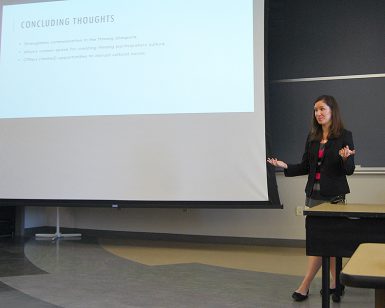Alumna Lopez discusses communication in Hmong diaspora

Despite having limited access to the Internet and traditional media, the American Hmong community found a new way to access information: conference calls.
Alumna Lori Kido Lopez, MA’08, now an assistant professor at the University of Wisconsin, presented “Mediating Hmong America: Participatory Cultures Beyond the Digital Divide” at a special joint session of Research Colloquium and Brown Bag Seminar Friday in Ernie Pyle Hall. Lopez’ new project looks at the Hmong diaspora in America and how it’s adopted a new form of digital communication in lieu of widespread access to traditional media in the native language.
Instead, the diaspora began using Hmong teleconference radio programs — a term Lopez coined to describe the use of conference call software — to get access to news, share stories and seek advice.
“It seems like Hmong people are being really cutting edge here,” Lopez said.
The Hmong people lack a traditional nation state and are a nomadic people, Lopez said, though the largest concentrations are in Southern China and Laos. She said Communist forces persecuted the Hmong after the Vietnam conflict because they assisted the American military. This forced them to leave their homes and seek refuge in other countries.
The Hmong diaspora, which is estimated at more than 260,000 people, is centered in Fresno, California; Madison, Wisconsin; and the Twin Cities in Minnesota, according to Lopez. Looking at the Hmong community in Wisconsin, Lopez said there’s a lack of understanding about how the disconnected groups communicate.
“Nobody has really been doing this kind of research, especially from a media studies perspective,” Lopez said.
Advertising-supported traditional media for the Hmong community is limited in the United States, Lopez said, as no daily newspapers in their native language exist and only a few radio stations and programs are broadcast.
“Building up ethnic media is really difficult,” Lopez said, especially for small ethnic groups like the Hmong.
The Hmong lacked a written language until the 1950s, when missionaries developed one, Lopez said, so the culture is based on oral tradition.
“Radio makes a lot of sense for Hmong in the diaspora,” she said.
Given the economics behind advertising-supported radio, Lopez said there are few AM or FM stations, but there are sub-channel stations and some community radio broadcasts.
“There still aren’t a lot of ways to access radio,” Lopez said, because people need to live within the broadcast distance.
Hmong people began using free online teleconference software in lieu of traditional radio, Lopez said. The conference calls have regulars DJs and programs featuring music, news, health topics and advice.
Lopez said the Hmong community bypassed traditional media gatekeepers and created their own virtual forum for communication. She said it’s an innovative use of technology in a culturally specific way.
In addition to the method of communication, Lopez said an interesting finding was that women play a major role in running and accessing these programs. Unlike traditional Hmong radio programs, Lopez said women set up and host programs on many of the teleconference radio programs and are the primary consumer.
“That really stood out to me,” she said.
Professor Radhika Parameswaran said Lopez looked at the Hmong community at the ground level to create a portrait of the diaspora and how people communicate. Lopez took a risk going into this community as an outsider, not knowing what she’d find and gathered data that showed something truly special happening, she added.
“This is what qualitative research can do,” she said, because someone can go out and produce original work.
Lopez’s presentation was a part of Indiana University’s observance of Asian American and Pacific Islander Heritage Month.

